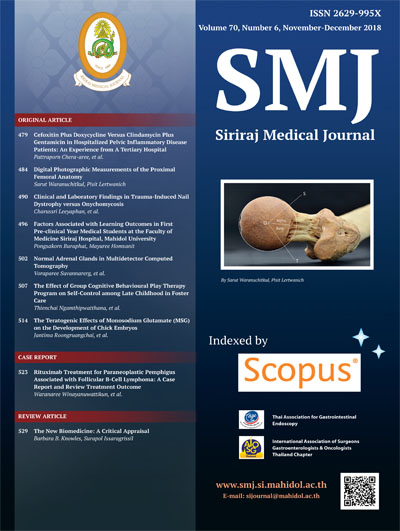Digital Photographic Measurements of the Proximal Femoral Anatomy
Keywords:
Digital photograph; femoral head-neck junction; femoral neck-shaft angle; femoroacetabular impingement syndrome; proximal femoral anatomyAbstract
Objective: This study evaluated the morphology of the proximal femur in the Thai population, especially the femoral head-neck relationship and the femoral neck-shaft relationship, using digital photographs.
Methods: The morphology of each proximal femur was evaluated via the standard anteroposterior and cephalocaudal views of digital photographs. The femoral head-neck junction morphology was evaluated for translation, rotation, and concavity. The femoral neck-shaft anatomy was measured with the neck-shaft angle and the neck version.
Results: Fifty-nine Thai femora with an average age of 45.4 years were evaluated. For the femoral head-neck translation, the average superior/inferior offset ratio was 1.01, and the average anterior/posterior offset ratio was 0.97. For the femoral head-neck rotation, the average anteroposterior and lateral physeal angles were 77.5° and 81.9°, respectively. Regarding the head-neck junction concavity, the average gamma, delta, alpha, and beta angles were 45.6°, 44.5°, 45.5°, and 36.2°, respectively. The average femoral neck-shaft angle was 129.5°, and the average femoral neck version was 5.7° of anteversion.
Conclusion: Thai femora had their heads located almost at the center of the femoral neck, and they were rotated in abduction and anteversion relative to the neck axis. The femoral head-neck junctions showed less concavity anteriorly and superiorly.
Downloads
Published
How to Cite
Issue
Section
License
Authors who publish with this journal agree to the following conditions:
Copyright Transfer
In submitting a manuscript, the authors acknowledge that the work will become the copyrighted property of Siriraj Medical Journal upon publication.
License
Articles are licensed under a Creative Commons Attribution-NonCommercial-NoDerivatives 4.0 International License (CC BY-NC-ND 4.0). This license allows for the sharing of the work for non-commercial purposes with proper attribution to the authors and the journal. However, it does not permit modifications or the creation of derivative works.
Sharing and Access
Authors are encouraged to share their article on their personal or institutional websites and through other non-commercial platforms. Doing so can increase readership and citations.











